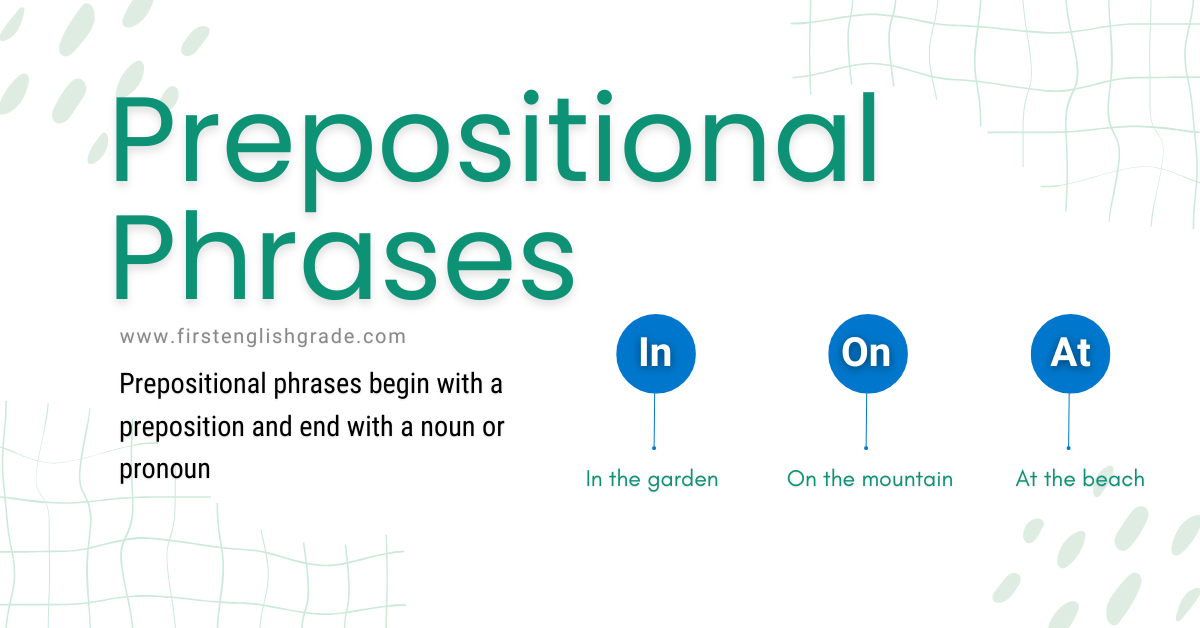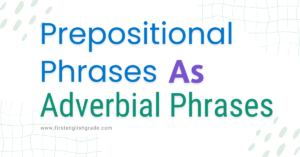Prepositional phrases are groups of words that show how things are connected in a sentence, like where, when, how, or why something happened. They can describe, give details, or point out locations. In this article, you will learn everything about prepositional phrases, which are groups of words that begin with a preposition and end with an object.
What are Prepositional Phrases?
A prepositional phrase is a group of words that adds information to a sentence by conveying relationships between nouns (or pronouns) and other elements in the sentence. These phrases often begin with a preposition and end with a noun or pronoun known as the object of the preposition.
Components of a Prepositional Phrase
1. Preposition
The foundation of a prepositional phrase lies in the preposition. A preposition is a word that indicates the relationship between its object and other elements in the sentence. Common prepositions include “on,” “in,” “at,” “under,” “over,” and “with.” These words act as connectors, providing important information about location, time, or direction. Example: “The book is on the shelf.” In this sentence, “on” is the preposition, conveying the spatial relationship between the book and the shelf.
2. Object of the Preposition
Every prepositional phrase has an object (noun or pronoun) that follows the preposition. This object is essential because it provides the specific detail or context that the preposition refers to. Identifying the object helps clarify the meaning of the entire prepositional phrase. Example: “She walked to the park.” Here “to” is the preposition, and “the park” is the object. Together, they form the prepositional phrase, indicating the direction of the walk.
Prepositional Phrases Examples
- I found my keys under the couch.
- Preposition: under
- Object of the Preposition: couch
- This prepositional phrase indicates the location where the keys were found.
- She painted a beautiful mural in the art class.
- Preposition: in
- Object of the Preposition: art class
- This prepositional phrase specifies the context of where the beautiful mural was painted.
- She travels by train every day.
- Preposition: by
- Object of the Preposition: train
- This prepositional phrase informs us about the mode of transportation she uses daily.
- He stood beside the tree during the storm.
- Preposition: beside
- Object of the Preposition: tree
- This prepositional phrase specifies the location where he stood during the storm.
Functions of Prepositional Phrases in Sentences
Prepositional phrases serve various functions in a sentence. They can indicate location, time, direction, possession, or manner.
Providing Location
- The cat is on the table.
- The children played in the park.
- My keys are under the cushion.
In these examples, the prepositional phrases “on the table,” “in the park,” and “under the cushion” provide essential details about where the action or the subject is located.
Indicating Time
- We will meet you at the library after school.
- The concert begins at 7 p.m.
- I usually take a break during lunch.
Here, prepositional phrases like “at the library after school,” “at 7 p.m.,” and “during lunch” add a temporal aspect to the sentences, indicating when the action is taking place.
Offering Direction
- The river flows through the valley.
- She walked along the beach.
- The airplane soared over the mountains.
These examples demonstrate how prepositional phrases indicate the direction of movement or the path. “Through the valley,” “along the beach,” and “over the mountains” provide crucial information about the movement or travel.
Demonstrating Possession
- The key to success is hard work.
- The door of the car was left open.
- The secret of happiness is gratitude.
Prepositional phrases in these instances convey a sense of ownership or association. “To success,” “of the car,” and “of happiness” highlight the connection between the subject and the object mentioned.
Describing Manner
- She spoke with confidence.
- He completed the task with precision.
- The children played with enthusiasm.
In these sentences, prepositional phrases such as “with confidence,” “with precision,” and “with enthusiasm” describe how the action is performed, providing insights into the manner or style of the activity.
How to Identify Prepositional Phrases
Identifying prepositional phrases is straightforward. First, keep an eye out for words that signal location, time, or relationships – these are prepositions. Once you spot a preposition, look for the noun or pronoun that follows it. This combination forms the prepositional phrase. For instance, in the sentence “The cat is on the roof,” “on” is the preposition, and “the roof” is the prepositional phrase indicating the cat’s location.
Additionally, words like “with,” “in,” or “before” often hint at prepositional phrases. In the sentence “She painted the wall with a brush,” “with” is the preposition, and ” with a brush” is the prepositional phrase describing how the painting was done. Practice reading sentences and spotting these word pairs – prepositions and their object – to become more skilled at identifying prepositional phrases effortlessly.
Common Prepositions in Prepositional Phrases
It is important to know the common prepositions because they help you spot those prepositional phrases in sentences. Prepositions basically connect nouns (or pronouns) with other stuff in the sentence, giving us important details. Check out the table below for some common prepositions, and their respective functions within prepositional phrases:
| Preposition | Description |
| In | Shows where something is |
| On | Tells us the position of something |
| Under | Describes where something is located below |
| With | Highlights who or what is accompanying |
| By | Points to the creator or the method used |
| For | Indicates the purpose or intended recipient |
| At | Specifies the place of a meeting or action |
| About | Gives the topic or subject |
| Between | Highlights the position in relation to two things |
Types of Prepositional Phrases
Adjective Prepositional Phrase
Adjective prepositional phrases modify nouns or pronouns by providing additional details. They often answer the questions, “Which one” or “What kind.” For example: “The cat with the fluffy tail is adorable”. Here, “With the fluffy tail” gives us more information about the cat, specifying the type of cat.
Adjective prepositional phrases examples:
- The girl in the purple dress is my sister.
- The house with the blue shutters is for sale.
- The student with the highest score won the award.
- The car with the broken headlights needs repairs.
Adverbial Prepositional Phrase
Adverbial prepositional phrases modify verbs, adjectives, or adverbs, answering questions like “how,” “when,” or “where” an action occurred. For example: “She walked to the store slowly.” In this sentence, “to the store” explains the direction of her walk, and “slowly” describes how she walked.
Examples:
- He ran across the street quickly.
- The birds chirped in the trees joyfully.
- They sang at the concert passionately.
Noun Prepositional Phrase
A “noun prepositional phrase” happens when a group of words that starts with a preposition (like “after,” “for,” or “in”) acts as a noun in a sentence. This group of words can do the jobs that nouns usually do, such as being the subject, object, or complement in a sentence. For example: “The decision of the committee was final.” In this instance, “of the committee” acts as a noun unit. It is the subject of the sentence, specifying whose decision was final.
Noun prepositional phrases examples:
- The color of the sky at sunset is beautiful.
- After the storm was quite a mess.
- They had a discussion about the project.
List of Prepositional Phrases
Common Prepositional Phrases in English are:
- In the garden
- On the mountain
- Under the bed
- Across the street
- Beside the river
- Against the wind
- During the movie
- At the beach
- Behind the curtain
- Through the forest
- Around the corner
- Without hesitation
- Inside the house
- Within the city
- Along the path
Example Sentences with Prepositional Phrases
- The children played in the garden until sunset.
- They built a cabin on the mountain for their vacations.
- The bakery is across the street from the bookstore.
- The flag flapped against the wind during the storm.
- Dreams can take you over the rainbow to magical places.
- We hiked through the forest to reach the hidden waterfall.
- The bakery is just around the corner from our apartment.
- The cat prefers to stay inside the house during the rain.
- There is a beautiful view of the hill overlooking the city.
- We walked along the path, enjoying the peaceful scenery.
Idiomatic Prepositional Phrases
Some prepositional phrases have idiomatic meanings that differ from the meanings of the individual words. These are called idiomatic prepositional phrases. For example, in the sentence “He is in trouble with his parents“, the prepositional phrase “in trouble with” does not mean that he is located inside some kind of trouble that belongs to his parents. Rather, it means he has done something wrong and his parents are angry or disappointed. This expression has a unique meaning that cannot be inferred from the words alone.
Some common idiomatic prepositional phrases in English:
- Under the weather
- Meaning: Feeling unwell or sick.
- Example: “Mr. Smith won’t be able to come today; he is a bit under the weather.”
- On the same page
- Meaning: In agreement or having a shared understanding.
- Example: “Please ensure you are all on the same page before presenting your ideas.”
- In the blink of an eye
- Meaning: Happening very quickly, almost instantaneously.
- Example: “The car disappeared in the blink of an eye.”
FAQs
Frequently Asked Questions (FAQs) about Prepositional Phrases:
Q1: What is a prepositional phrase?
A prepositional phrase is a group of words that begins with a preposition (like “in,” “on,” or “with”) and includes its object. It provides additional information about a noun or pronoun in a sentence.
Q2: How do I identify prepositional phrases in a sentence?
Look for words that indicate relationships, such as “on,” “in,” or “under.” Once you find a preposition, check the words that follow it. That combination forms the prepositional phrase.
Q3: What are idiomatic prepositional phrases?
Idiomatic prepositional phrases are combinations of words that, when used together, have a meaning that differs from the meanings of the individual words. For example, “on cloud nine” means “extremely happy.”
Q4: Can a prepositional phrase stand alone as a complete sentence?
No, a prepositional phrase typically cannot stand alone as a complete sentence. It needs to be part of a larger sentence to convey a complete thought.
Q5: How to use prepositional phrases as adjectives?
Prepositional phrases can act as adjectives by modifying nouns. For example, “The book on the shelf is my favorite.” Here, “on the shelf” describes which book.
Q6: How to use prepositional phrases as adverbs?
Prepositional phrases can function as adverbs by modifying verbs, adjectives, or other adverbs. For instance, “She ran with determination.” Here, “with determination” describes how she ran.
Q7: How to use prepositional phrases as nouns?
Prepositional phrases can act as nouns by serving as the subject, object, or complement in a sentence. For example, “His dream is to travel around the world.” Here, “around the world” is the complement, acting as a noun.




